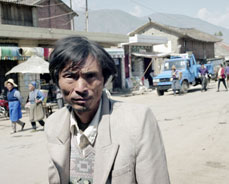" So I then met my first chinaman
I thought that he didn't look at all like a chinaman.
But no wonder.
I had never met a chinaman before."
This may have applied to the writer Haruki Murakami, but by no means to Margret Nielsen, having seen Chinese faces in countless other images. However, her series of photographs, visual trophies collected from travels in the last three years, show with surprising clarity that there is not a chinese look as such. Not only Murakami would have been amazed by the diversity shown in these photos.
Covering an area of 9,5 million square kilometres and with a population of almost 1,3 billion, China by no means a homogeneous state. It is a country on the brink; the photos clearly show the contrasts between rich and poor, city and countryside. It is in the rural areas that the diversity of people can be seen; some faces could make you think you were in the Caucasus or in Eastern Europe, until a moment later it is obvious that you are in China and nowhere else. China shows itself as a country caught between the traditional and the modern. Chairman Mao is still around in the background, on posters in street cafés, as a statue in public places, and, of course, in the Tiananmen square in Peking.
With the curiosity that the western European has when abroad, the photographer at the same time is the focus of interest, whether in the metropolis or in a small village and, in reverse, draws curious stares.
Here and there, a door is opened at the back of a restaurant, heads turn round the doorway in curiosity, venturing glances, whispers and giggles towards the strange European woman sitting there.
And, they think to themselves, she does not even look like an European.







